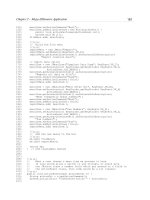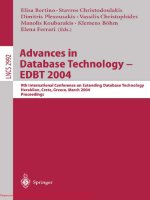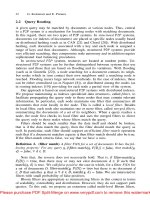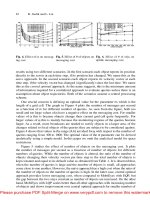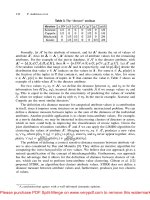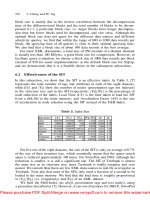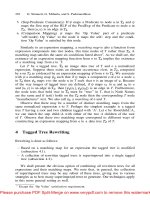Tài liệu Advances in Database Technology- P9 docx
Bạn đang xem bản rút gọn của tài liệu. Xem và tải ngay bản đầy đủ của tài liệu tại đây (1.11 MB, 50 trang )
382
J. Zhang et al.
Fig. 21.
Cost vs.
Fig. 22. Cost vs.
made in [CMTV00]). On the other hand, the density of S does not affect significantly
the accesses to the obstacle R-tree because high density leads to closer distance
between the Euclidean pairs. The CPU time of the algorithm (shown in Fig. 21b)
grows fast with because the dominant factor is the computation required for
obtaining the Euclidean closest pairs (as opposed to obstructed distances).
Fig. 22 shows the cost of the algorithm with for different values of k.
The page accesses for the entity R-trees (caused by the Euclidean CP algorithm)
remain almost constant, since the major cost occurs before the first pair is output (i.e.,
the k closest pairs are likely to be in the heap after the first Euclidean NN is found,
and are returned without extra IOs). The accesses to the obstacle R-tree and the CPU
time, however, increase with k because more obstacles must be taken into account
during the construction of the visibility graphs.
8
Conclusion
This paper tackles spatial query processing in the presence of obstacles. Given a set of
entities P and a set of polygonal obstacles O, our aim is to answer spatial queries with
respect to the obstructed distance metric, which corresponds to the length of the
Please purchase PDF Split-Merge on www.verypdf.com to remove this watermark.
Spatial Queries in the Presence of Obstacles
383
shortest path that connects them without passing through obstacles. This problem has
numerous important applications in real life, and several main memory algorithms
have been proposed in Computational Geometry. Surprisingly, there is no previous
work for disk-resident datasets in the area of Spatial Databases.
Combining techniques and algorithms from both aforementioned fields, we
propose an integrated framework that efficiently answers most types of spatial queries
(i.e., range search, nearest neighbors, e-distance joins and closest pairs), subject to
obstacle avoidance. Making use of local visibility graphs and effective R-tree
algorithms, we present and evaluate a number of solutions. Being the first thorough
stud
y
of this problem in the context of massive datasets, this paper opens a door to
several interesting directions for future work. For instance, as objects move in
practice, it would be interesting to study obstacle queries for moving entities and/or
moving obstacles.
References
[AGHI86]
[BKOS97]
[BKS93]
[BKSS90]
[CMTV00]
[D59]
[EL01]
[G84]
[GM87]
[HS98]
[HS99]
[KHI+86]
[LW79]
[PV95]
[PV96]
[PZMT03]
[R95]
Asano, T., Guibas, L., Hershberger, J., Imai, H. Visibility of Disjoint Polygons.
Algorithmica 1, 49-63, 1986.
de Berg, M., van Kreveld, M., Overmars, M., Schwarzkopf, O. Computational
Geometry, pp. 305-315, Springer, 1997.
Brinkhoff, T., Kriegel, H., Seeger, B. Efficient Processing of Spatial Joins Using
R-trees. SIGMOD, 1993.
Becker, B., Kriegel, H., Schneider, R, Seeger, B. The R*-tree: An Efficient and
Robust Access Method. SIGMOD, 1990.
Corral, A., Manolopoulos, Y., Theodoridis, Y., Vassilakopoulos, M. Closest Pair
Queries in Spatial Databases. SIGMOD, 2000.
Dijkstra, E. A Note on Two Problems in Connection with Graphs. Numeriche
Mathematik, 1, 269-271, 1959.
Estivill-Castro, V., Lee, I. Fast Spatial Clustering with Different Metrics in the
Presence of Obstacles. ACM GIS, 2001.
Guttman, A. R-trees: A Dynamic Index Structure for Spatial Searching. SIGMOD,
1984.
Ghosh, S., Mount, D. An Output Sensitive Algorithm for Computing Visibility
Graphs. FOCS, 1987.
Hjaltason, G., Samet, H. Incremental Distance Join Algorithms for Spatial
Databases. SIGMOD, 1998.
Hjaltason, G., Samet, H. Distance Browsing in Spatial Databases. TODS, 24(2),
265-318, 1999.
Kung, R., Hanson, E., Ioannidis, Y., Sellis, T., Shapiro, L. Stonebraker, M.
Heuristic Search in Data Base Systems. Expert Database Systems, 1986.
Lozano-Pérez, T., Wesley, M. An Algorithm for Planning Collision-free Paths
among Polyhedral Obstacles. CACM, 22(10), 560-570, 1979.
Pocchiola, M., Vegter, G. Minimal Tangent Visibility Graph. Computational
Geometry: Theory and Applications, 1995.
Pocchiola, M., Vegter, G. Topologically Sweeping Visibility Complexes via
Pseudo-triangulations. Discrete Computational Geometry, 1996.
Papadias, D., Zhang, J., Mamoulis, N., Tao, Y. Query Processing in Spatial
Network Databases. VLDB, 2003.
Rivière, S. Topologically Sweeping the Visibility Complex of Polygonal Scenes.
Symposium on Computational Geometry, 1995.
Please purchase PDF Split-Merge on www.verypdf.com to remove this watermark.
384
J. Zhang et al.
[SRF87]
[SS84]
[THH01]
[W85]
[Web]
Sellis, T., Roussopoulos, N. Faloutsos, C. The R+-tree: a Dynamic Index for
Multi-Dimensional Objects. VLDB, 1987.
Sharir, M., Schorr, A. On Shortest Paths in Polyhedral Spaces. STOC, 1984.
Tung, A., Hou, J., Han, J. Spatial Clustering in the Presence of Obstacles. ICDE,
2001.
Welzl, E. Constructing the Visibility Graph for n Line Segments in Time,
Information Processing Letters 20, 167-171, 1985.
/>Please purchase PDF Split-Merge on www.verypdf.com to remove this watermark.
NNH: Improving Performance of
Nearest-Neighbor Searches Using Histograms
Liang Jin
1
*
, Nick Koudas
2
, and Chen Li
1
*
1
Information and Computer Science, University of California, Irvine, CA 92697, USA
{liangj,chenli}@ics.uci.edu
2
AT&T Labs Research, 180 Park Avenue, Florham Park, NJ 07932, USA
Abstract. Efficient search for nearest neighbors (NN) is a fundamental
problem arising in a large variety of applications of vast practical interest.
In this paper we propose a novel technique, called NNH (“Nearest Neigh-
bor Histograms”), which uses specific histogram structures to improve
the performance of NN search algorithms. A primary feature of our pro-
posal is that such histogram structures can co-exist in conjunction with
a plethora of NN search algorithms without the need to substantially
modify them. The main idea behind our proposal is to choose a small
number of pivot objects in the space, and pre-calculate the distances
to their nearest neighbors. We provide a complete specification of such
histogram structures and show how to use the information they provide
towards more effective searching. In particular, we show how to construct
them, how to decide the number of pivots, how to choose pivot objects,
how to incrementally maintain them under dynamic updates, and how
to utilize them in conjunction with a variety of NN search algorithms
to improve the performance of NN searches. Our intensive experiments
show that nearest neighbor histograms can be efficiently constructed and
maintained, and when used in conjunction with a variety of algorithms
for NN search, they can improve the performance dramatically.
1
Introduction
Nearest-neighbor (NN) searches arise in a large variety of applications such as
image and video databases [1], CAD, information retrieval (IR) [2], data com-
pression [3], and string matching/searching [4]. The basic version of the
problem is to find the nearest neighbors of a query object in a database,
according to a distance measurement. In these applications, objects are often
characterized by features and represented as points in a multi-dimensional space.
For instance, we often represent an image as a multi-dimensional vector using
features such as histograms of colors and textures. A typical query in an image
database is to find images most similar to a given query image utilizing such fea-
tures. As another example, in information retrieval, one often wishes to locate
*
These two authors were supported by NSF CAREER award No. IIS-0238586 and a
UCI CORCLR grant.
E. Bertino et al. (Eds.): EDBT 2004, LNCS 2992, pp. 385–402, 2004.
© Springer-Verlag Berlin Heidelberg 2004
Please purchase PDF Split-Merge on www.verypdf.com to remove this watermark.
386
L. Jin, N. Koudas, and C. Li
documents that are most similar to a given query document, considering a set
of features extracted from the documents [2].
Variations of the basic problem include high-dimensional joins between
point sets. For instance, an all-pair neighbor join between two point
sets seeks to identify the closest pairs among all pairs from two sets [5,6]. An
all-pair neighbor semi-join between two point sets reports, for each
object in one data set, its nearest neighbors in the second set [5].
Many algorithms have been proposed to support nearest-neighbor queries.
Most of them use a high-dimensional indexing structure, such as an R-tree [7]
or one of its variations. For instance, in the case of an R-tree, these algorithms
use a branch-and-bound approach to traverse the tree top down, and use dis-
tance bounds between objects to prune branches (minimum-bounding rectangles,
MBR’s) that do not need to be considered [8,9]. A priority queue of interior nodes
is maintained based on their distances to the query object. In the various forms
of high-dimensional joins between point sets, a queue is maintained to keep track
of pairs of objects or nodes in the two data sets.
One of the main challenges in these algorithms is to perform effective pruning
of the search space, and subsequently achieve good search performance. The per-
formance of such an algorithm heavily depends on the number of disk accesses
(often determined by the number of branches visited in the traversal) and its run-
time memory requirements, which indicates memory (for priority-queue storage)
and processor requirements for maintaining and manipulating the queue. Perfor-
mance can deteriorate if too many branches are visited and/or too many entries
are maintained in the priority queue, especially in a high-dimensional space due
to the well-known “curse of dimensionality” problem [1].
In this paper we develop a novel technique to improve the performance of
these algorithms by keeping histogram structures (called “NNH”). Such struc-
tures record the nearest-neighbor distances for a preselected collection of objects
(“pivots”). These distances can be utilized to estimate the distance at which the
neighbors for each query object can be identified. They can subse-
quently be used to improve the performance of a variety of nearest-neighbor
search and related algorithms via more effective pruning. The histogram struc-
tures proposed can co-exist in conjunction with a plethora of NN algorithms
without the need to substantially modify these algorithms.
There are several challenges associated with the construction and use of such
structures. (1) The construction time should be small, their storage requirements
should be minimal, and the estimates derived from them should be precise. (2)
They should be easy to use towards improving the performance of a variety of
nearest-neighbor algorithms. (3) Such structures should support efficient incre-
mental maintenance under dynamic updates. In this paper we provide a complete
specification of such histogram structures, showing how to efficiently and accu-
rately construct them, how to choose pivots effectively, how to incrementally
maintain them under dynamic updates, and how to utilize them in conjunction
with a variety of NN algorithms to improve the performance of searches.
Please purchase PDF Split-Merge on www.verypdf.com to remove this watermark.
NNH: Improving Performance of Nearest-Neighbor Searches
387
The rest of the paper is organized as follows. Section 2 outlines the formal
definition of a nearest-neighbor histogram (NNH) structure. In Section 3 we
show how to use such histograms to improve the performance for a variety of
NN algorithms. Section 4 discusses how to choose pivots in such a structure.
In Section 5 we discuss how to incrementally maintain an NN histogram struc-
ture in the presence of dynamic updates. In Section 6 we report our extensive
experimental results, evaluating the construction time, maintenance algorithms,
and the efficiency of our proposed histograms when used in conjunction with a
variety of algorithms for NN search to improve their performance. Due to space
limitation, we provide more results in [10].
Related Work: Summary structures in the form of histograms have been
utilized extensively in databases in a variety of important problems, such as
selectivity estimation [11,12] and approximate query answering [13,14]. In these
problems, the main objective is to approximate the distribution of frequency
values using specific functions and a limited amount of space.
Many algorithms exist for efficiently identifying the nearest neighbors of low
and high-dimensional data points for main memory data collections in the field
of computational geometry [15]. In databases, many different families of high-
dimensional indexing structures are available [16], and various techniques are
known for performing NN searches tailored to the specifics of each family of
indexing structures. Such techniques include NN searches for the entity grouping
family of indexing structures (e.g., R-trees [7]) and NN searches for the space
partitioning family (e.g., Quad-trees [17]). In addition to the importance of NN
queries as stand-alone query types, a variety of other query types make use of
NN searches. Spatial or multidimensional joins [18] are a representative example
of such query types. Different algorithms have been proposed for spatial NN
semi-joins and all-pair NN joins [5]. NN search algorithms can benefit from the
histogram structures proposed in this paper enabling them to perform more
effective pruning. For example, utilizing a good estimate to the distance of the
nearest neighbor of a query point, one can form essentially a range query
to identify nearest neighbors, using the query object and the estimated distance
and treating the search algorithm as a “black box” without modifying its code.
Various studies [19,20,21,22] use notions of pivots or anchors or foci for effi-
cient indexing and query processing. We will compare our approach with these
methods in Section 6.4.
2
NNH: Nearest-Neighbor Histograms
Consider a data set with objects in a Euclidean space
under some form. Formally, there is a distance function
such that given two objects and their distance is defined as
and are coordinates of objects and respectively.
Please purchase PDF Split-Merge on www.verypdf.com to remove this watermark.
388
L. Jin, N. Koudas, and C. Li
Definition 1. (NN Search) Given a query object, a Neighbor (NN)
search returns the points in the database that are closest to the query object.
Given an object in the space, its NN distance vector of size is a vector
in which each is the distance of nearest neighbor
in the database D. A nearest-neighbor histogram (NNH) of the data set, denoted
H, is a collection of objects (called “pivots”) with their NN vectors. In principle,
these pivot points may or may not correspond to points in the database. In the
rest of the paper, we assume that the pivots are not part of the data set for
the purpose of easy dynamic maintenance, as discussed in Section 5. Initially all
the vectors have the same length, denoted T, which is a design parameter and
forms an upper bound on the number of neighbors NN queries specify as their
desired result. We choose to fix the value of
T
in order to control the storage
requirement for the NNH structure [23]. For any pivot let denote the
distance of recorded in H. Let
denote the NN vector for a pivot in the histogram H.
Fig. 1. An NN histogram structure H.
Figure 1 shows such a structure. It has pivots, each of which has
an NN vector of size T = 6. For instance,
and In Section 4 we discuss how to choose pivots to construct
a histogram. Once we have chosen pivots, for each of them, we run a T-NN
search to find all its T nearest neighbors. Then, for each we
calculate the distance from the nearest neighbor to the object and use
these T distances to construct an NN vector for
3
Improving Query Performance
In this section we discuss how to utilize the information captured by nearest
neighbor histograms to improve query performance. A number of important
queries could benefit from such histograms, including neighbor search
and various forms of high-dimensional joins between point sets, such as
all-pair neighbor joins (i.e., finding closest pairs among all the pairs
Please purchase PDF Split-Merge on www.verypdf.com to remove this watermark.
NNH: Improving Performance of Nearest-Neighbor Searches
389
between two data sets), and neighbor semi-joins (i.e., finding NN’s
in the second data set for each object in the first set). The improvements to
such algorithms are twofold: (a) the processor time can be reduced substantially
due to advanced pruning. This reduction is important since for data sets of
high dimensionality, distance computations are expensive and processor time
becomes a significant fraction of overall query-processing time [24]; and (b) the
memory requirement can be reduced significantly due to the much smaller queue
size. Most NN algorithms assume a high-dimensional indexing structure on the
data set. To simplify our presentation, we choose to highlight how to utilize our
histogram structures to improve the performance of common queries involving
R-trees [7]. Similar concepts carry out easily to other structures (e.g. SS-tree [25],
SR-tree [26], etc.) and algorithms as well.
3.1
Utilizing Histograms in
Queries
A typical search involving R-trees follows a branch-and-bound strategy
traversing the index top down. It maintains a priority queue of active minimum
bounding rectangles (MBR’s) [8,9]. At each step, it maintains a bound to the
distance, from the query point This bound is initialized to infinity
when the search starts. Using the geometry of an MBR mbr and the coordinates
of query object an upper-bound distance of to the nearest point in the
mbr, namely can be derived [27]. In a similar fashion,
a lower bound, namely is derived. Using these estimates,
we can prune MBR’s from the queue as follows: (1) For an MBR mbr, if its
is greater than of another MBR
then mbr can be pruned. (2) If for an MBR mbr is
greater than then this mbr can be pruned.
In the presence of NN histograms, we can utilize the distances to estimate an
upper bound of the of the query object Recall that the NN histogram
includes the NN distances for selected pivots only, and it does not convey immedi-
ate information about the
distances of objects not encoded in the histogram
structure. We can estimate the distance of
to its
denoted using the
triangle inequality between and any pivot in the histogram:
Thus, we can obtain an upper bound estimate of as
The complexity of this estimation step is Since the histogram structure
is small enough to fit in the memory, and the number of pivots is small, the above
estimation can be conducted efficiently. After computing the initial estimate
1
Note that we use instead of because in this paper we assume
that the pivots are not part of the database.
NN
Please purchase PDF Split-Merge on www.verypdf.com to remove this watermark.
390
L. Jin, N. Koudas, and C. Li
we can use this distance to help the search process prune MBR’s. That is, the
search progresses by evaluating MINMAXDIST and MINDIST between
and an R-tree MBR mbr as before. Besides the standard pruning steps discussed
above, the algorithm also checks if
is true. If so, then this mbr can be pruned. Thus we do not need to insert it
into the queue, reducing the memory requirement (queue size) and the later
operations of this MBR in the queue.
Notice that the algorithm in [8,9] is shown to be IO optimal [28]. Utilizing our
NNH structure may not reduce the number of IOs during the R-tree traversal.
However, our structure can help reduce the size of the priority queue, and the
number of queue operations. This reduction can help reduce the running time
of the algorithm, as shown in our experiments in Section 6. In addition, if the
queue becomes too large to fit into memory, this reduction could even help us
reduce the IO cost since part of the queue needs to be paged on disk.
3.2
Utilizing Histograms in
Joins
A related methodology could also be applied in the case of all-pairs join
queries using R-trees. The bulk of algorithms for this purpose progress by insert-
ing pairs of MBR’s between index nodes from corresponding trees in a priority
queue and recursively (top-down) refining the search. In this case, using
histograms, one could perform, in addition to the type of pruning highlighted
above, even more powerful pruning.
More specifically, let us see how to utilize such a histogram to do pruning
in a semi-join search [5]. This problem tries to find for each object
in a data set all neighbors in a data set (This pruning
technique can be easily generalized to other join algorithms.) If the two data
sets are the same, the join becomes a self semi-join, i.e., finding for all
objects in the data set. Assume the two data sets are indexed in two R-trees,
and respectively. A preliminary algorithm described in [5] keeps a priority
queue of MBR pairs between index nodes from the two trees. In addition, for
each object in we can keep track of objects in whose pair
has been reported. If we can just keep track of objects whose nearest
neighbor has been reported. For we can output its nearest neighbors while
traversing the trees, thus we only need to keep a counter for this object We
stop searching for neighbors of this object when this counter reaches
Suppose we have constructed a histogram for data set We can utilize
to prune portions of the search space in bulk by pruning pairs of MBR’s from
the priority queue as follows. For each object in besides the information
kept in the original search algorithm, we also keep an estimated radius of
the in for this object. We can get an initial estimate for as before
(Section 3.1). Similarly, we will not insert a pair into the queue if
MINDIST In this way we can prune more object-MBR pairs.
Please purchase PDF Split-Merge on www.verypdf.com to remove this watermark.
NNH: Improving Performance of Nearest-Neighbor Searches
391
Now we show that this histogram is even capable to prune MBR-MBR pairs.
For each MBR in tree consider a pivot in the NN histogram of
dataset For each possible object in using the triangle inequality
between and we know that the distance to
is an upper bound of the distance between any object in
and object Therefore,
is an upper bound for the distance for any object in It can be used
to prune any from the queue, if
is true, where is the lower bound of the distance be-
tween any pair of objects from and respectively. In order to use this
technique to do pruning, in addition to keeping an estimate for the distance of
the for each object in data set we also keep an estimate of distance
for each MBR in This number tends to be smaller than the
number of objects in These MBR-distance estimates can be used to prune
many MBR-MBR pairs, reducing the queue size and the number of disk IO’s.
Pruning in all-pair neighbor joins: The pruning techniques de-
scribed above can be adapted to perform more effective pruning when finding
the pairs among all pairs of objects from two data sets [5,6]. Notice
that so far we have assumed that only has a histogram If the first data
set also has a histogram similar pruning steps using can be done to
do more effective pruning, since the two sets are symmetric in this join problem.
4
Constructing NNH Using Good Pivots
Pivot points are vital to NNH for obtaining distance estimates in answering NN
queries. We now turn to the problems associated with the choice of pivot points,
and the number of pivots. Assume we decide to choose pivot points. The
storage requirement for NNH becomes since for each pivot point we
will associate a vector of distances to its T-NN’s. Let the pivot points be
Given a query point we can obtain an estimate to the distance of
by returning
This estimate is an upper bound of the real distance of to its point and
is obtained utilizing the triangle inequality, among a pivot point and
point. Assuming that the true distance of to its is This
estimation incurs an error of
Please purchase PDF Split-Merge on www.verypdf.com to remove this watermark.
392
L. Jin, N. Koudas, and C. Li
The expected error for the estimation of any query becomes:
The larger the number of pivot points the larger the space requirements of
the corresponding NNH structure. However, the larger the higher the chances
of obtaining a more accurate estimate It is evident that by increasing the
number of pivot points, we increase the storage overhead of NNH, but potentially
improve its estimation accuracy.
4.1
Choosing Pivots
Given the number of pivot points devoted to the NNH, we want to choose the
best pivots to minimize the expected distance estimation error for any query
Query points are not known in advance, and any query point on the data
set D could be equally likely. Moreover, the parameter in a distance
estimate is also not known in advance, but provided at run time. At best we are
aware of an upper bound for it. For this reason, we decide to minimize the term
providing the estimate to the query, by choosing as pivot points the set S
of points that minimize the quantity:
That is, we minimize distances to pivot points assuming queries are points of D.
This goal is the well-known objective of the clustering problem and consequently
we obtain the cluster centroids of D, as pivots. It is, in expectation, the best
choice of pivots, provided that query points belong to
D
, assuming no
knowledge of the number of NN points queries specify. This choice has the
added utility of enabling a plethora of known clustering algorithms (e.g., [29,
30]) to be applied in our problem of selecting the pivots.
4.2
Choosing the Number of Pivots
We now present our methodology for deciding the number of pivots to use
when constructing an NNH structure. We start by describing a way to quantify
the benefits of an NNH with a given number of pivots. Consider an NN search
for a query object We use both the standard algorithm [8] and the improved
one described in Section 3.1. The queue-size-reduction ratio of the NNH with
pivots for this search is:
Please purchase PDF Split-Merge on www.verypdf.com to remove this watermark.
NNH: Improving Performance of Nearest-Neighbor Searches
393
This ratio indicates how much memory the NNH can save by reducing the queue
size. Notice that we could also use the kNN semi-join operation to define the
corresponding queue-size-reduction ratio. Our experiments showed no major dif-
ference between the results of these two definitions, so we adopt the former
operation for defining queue-size-reduction.
Given a number we use the approach in Section 4.1 to find good
pivots. We randomly select a certain number (say, 10) of objects in the data set
to perform NN searches, and calculate the average of their queue-size-reduction
ratios. The average value, denoted is a good measurement of the benefits
of the NNH with pivots. In particular, using standard tail inequality theory
[31] one can show that such an estimate converges (is an unbiased estimate) to
the true benefit for random queries as the size of the sample grows. We omit the
details due to lack of space.
Our algorithm for deciding the value for a data set is shown in Figure 2.
Its main idea is as follows: we first initialize to a small number (e.g., 5)
and measure the average queue-size-reduction ratio Then we increment the
number of pivots (using the parameter SP) and judge how much benefit (in
terms of the reduction ratio) the increased number of pivots can achieve. When
there is no big difference (using the parameter between consecutive rounds,
the algorithm terminates and reports the current number of pivots.
One potential problem of this iterative algorithm is that it could “get stuck”
at a local optimal number of pivots (since the local gain on the reduction ratio
becomes small), although it is still possible to achieve a better reduction ratio
using a larger pivot number. We can modify the algorithm slightly to solve this
Fig. 2.
Algorithm for deciding pivot number
Please purchase PDF Split-Merge on www.verypdf.com to remove this watermark.
394
L. Jin, N. Koudas, and C. Li
problem. Before the algorithm terminates, it “looks forward” to check a larger
pivot number, and see if we can gain a better reduction ratio. Techniques for
doing so are standard in hill-climbing type of algorithms [32] and they can be
readily incorporated if required.
5
Incremental Maintenance
In this section we discuss how to maintain an NN histogram in the presence
of dynamic updates (insertions/deletions) in the underlying database. Under
dynamic updates, a number of important issues arise. When a new object is
inserted, it could affect the structure of the nearest neighbors of many pivots,
possibly prompting changes to their NN vectors. Similarly, when an object is
deleted, it could also change the NN structure of pivots. We associate a separate
value for each pivot which identifies the number of positions (starting
from the beginning) in the vector that can be utilized to provide distance
estimates. All the distances after the position cannot be used for NN
distance-estimation purposes, since as a result of some update operations they
are not valid anymore. Initially, for all the pivots.
Insertion: Upon insertion of an object into the data set, we perform the
following task. For each pivot whose nearest neighbors may include
we need to update their NN vectors. We scan all the pivots in the histogram, and
for each pivot we compute the distance between and the new object, i.e.,
Consider the distance vector of in the NN histogram:
We locate the position of in this vector. Assume
where There are two cases. (1) Such a position cannot be found. Then this
new object cannot be among the nearest neighbors of and we do not need
to update this NN vector. (2) Such a position is found. cannot be among
the (j-1)-NN objects of Therefore, we can insert this distance to
the slot in the NN vector, and shift the distances after the slot to
the right. Correspondingly, we increment the number of valid distances for this
vector by 1. If becomes larger than T, we set
Deletion: When deleting an object we need to update the vectors for
the pivots whose nearest neighbors may have included For each pivot
similarly to the insertion case, we consider the distance vector of in H. We
locate the position of in this vector and update the vector similarly to
the insertion case, except now we need to shrink the vector if necessary. Notice
that in this paper we assume that the pivots are not part of the database, deleting
a data point from the database will not affect the formation of pivots. It only
could change the values in the NN vectors.
The worst case complexity of each procedure above for insertions and dele-
tions is where is the number of pivots in the histogram,
and T is the maximal length of each distance vector. The reason is that we can
do a binary search to find the inserting position of or in
Please purchase PDF Split-Merge on www.verypdf.com to remove this watermark.
NNH: Improving Performance of Nearest-Neighbor Searches
395
the NN vector of which takes O(log(T)) time. If the position is found, we
need O(T) time to shift the rest of the vector (if we use a simple array imple-
mentation of the vector in memory). This operation is executed for all the
pivots in the histogram. Since the number of pivots is small and the histogram
can fit in memory, the maintenance cost is low (see Section 6.3). After many
insertions and deletions, if the valid length of an NN vector becomes too small,
we can recompute a new NN distance for this pivot by doing a T-NN search. In
addition, we can periodically run the algorithms in Section 4 to choose a new
collection of pivots and construct the corresponding NN histogram.
6
Experiments
In this section we present the results of an experimental evaluation assessing
the utility of the proposed NNH techniques when used in conjunction with al-
gorithms involving NN searches. We used two datasets in the evaluation. (1)
A Corel image database (Corel). It consists of 60,000 color histogram features.
Each feature is a 32-dimensional float vector. (2) A time-series data set from
the AT&T Labs. It consists of 5 million numerical values generated for a fixed
time span. We constructed datasets with different dimensionalities by using dif-
ferent time-window sizes. Both datasets exhibit similar trend in the results. We
mainly focus on reporting the results of the Corel image database. We will use
the time-series data to show the effects of dimensionality in our NNH approach
and evaluate different approaches to choosing pivots.
All experiments were performed on a SUN Ultra 4 workstation with four
300MHz CPU’s and 3GB memory, under the SUN OS 4.7 operating system.
The software was compiled using GNU C++, using its maximum optimization
(“-O4”). For the priority queue required in the algorithm described in [8,9], we
used a heap implementation from the Standard Template Library [33].
6.1
Improving
Search
We present experiments showing the effectiveness of NNH for NN searches using
R-trees on the Corel database. In general, any indexing technique that follows a
branch-and-bound strategy to answer NN queries can be used. As an example,
we implemented the algorithm described in [8,9], using an R-tree with a
page size of 8,192 bytes. We refer to this algorithm as the “standard version”
of the NN search. We assume that a query object may not belong to the data
set. We performed pruning as described in Section 3.1. We refer to it as the
“improved version” of the NN algorithm.
Reducing Memory Requirements and Running Time: Several impor-
tant factors affect the performance of a search including memory usage,
running time, and number of IO’s. Memory usage impacts running time signif-
icantly, since the larger the priority queue gets, the more distance comparisons
the algorithm has to perform. At large dimensionality, distance comparisons are
a significant fraction of the algorithm’s running time.
Please purchase PDF Split-Merge on www.verypdf.com to remove this watermark.
396
L. Jin, N. Koudas, and C. Li
Fig. 3. Queue size of k-NN search.
Fig. 4. Running Time for 10-NN queries.
We use the size of the priority queue to measure memory usage, since ad-
ditional memory requirements are relatively small. Figure 3 shows the maximal
queue size and the average queue size for the standard and improved versions of
the NN algorithm. We first ran a algorithm to generate 100 pivots, and
constructed the NN histogram with T = 50. Then we performed 10-NN queries
for 100 randomly generated query objects, and calculated the average number
for both the maximal queue size and the average queue size. We observe that
we can reduce both the queue sizes dramatically by utilizing the NNH to prune
the search. For instance, when searching for the 10-NN’s for a query object, the
average queue size of the standard version was 5,036, while it was only 1,768 for
the improved version, which was only about 35% of that of the standard version.
Figure 4 shows the running times for different dataset sizes for both versions,
when we ran 10-NN queries. The improved version can always speed up the
query as the size increases. This improvement increases as the size of the dataset
increases. The reason is that, increasing the size of the dataset increases the
size of the priority queue maintained in the algorithm. As a result, the standard
version has to spend additional processor time computing distances between
points and MBR’s of the index. In contrast the effective pruning achieved by the
improved version reduces this overhead.
Choosing the Number of Pivots: As discussed in Section 4, by choosing
the pivots using cluster centroids, the larger the number of pivots, the better the
distance estimates, and as a result the better performance improvement. Figure 5
shows the performance improvement for different numbers of pivots when we ran
10-NN queries for the 60,000-object Corel data set. The first data point in the
figure represents the standard version: its maximum queue size is 13, 772, its
average queue size is 6,944. It is shown that as the number of pivots increases,
both the maximal queue size and the average queue size decrease. For instance,
by keeping only 100 pivots, we can reduce the memory requirement by more
than 66%. This improvement increases as we have more pivots. The extra gain
for this data set is not significant, exhibiting a diminishing-returns phenomenon.
As a result, it is evident that for this data set, an NNH of very small size can
offer very large performance advantages. Our algorithm in Section 4.2 reported
Please purchase PDF Split-Merge on www.verypdf.com to remove this watermark.
NNH: Improving Performance of Nearest-Neighbor Searches
397
Fig. 5.
Performance for different # of pivots
100 as the “optimal” number of pivots with and SP = 5. This result
is consistent with the intuition obtained by the observation of Figure 5. We also
deployed the suitable queue-size-reduction ratio definition for semi-join,
and obtained similar results.
6.2
Improving
Joins
We implemented the semi-join algorithm in [5]. We performed a semi-join
using two different subsets and (with the same size) of objects in the Corel
data set, to find neighbors for each object in allowing to vary
from 1 to 50. We constructed an NNH for with 100 pivots and T = 50.
We implemented the approach in Section 3.2 to prune the priority queue. During
the traversal, we tried to perform a depth-first search on the R-tree of the first
data set, so that pruning for the objects in the trees enabled by the histograms
can be used as early as possible.
Reducing Memory Requirements and Running Time: We collected
the maximal and average queue sizes for both the standard version and the im-
proved one. Figure 6(a) presents the results. It is shown that additional pruning
using the NNH histograms makes the semi-join algorithm much more efficient.
For instance, when we performed a 10-NN semi-join search, the maximal and
average queue size of the standard version were 10.2M (million) and 6.3M re-
spectively, while it was only 2.1M and 1.2M for the improved version.
We also measured the running time for both versions. The results are shown
in Figure 6(b). Clearly by using the improved version, we can reduce the running
time dramatically. For instance, when performing a 10-NN semi-join, utilizing
the NNH structure we can reduce the time from 1,132 seconds to 219 seconds.
Figure 7(a) and (b) show the running times and queue sizes for different
data sizes. The figures show that as the data size increases, the semi-join
with pruning achieves significant performance advantages.
To evaluate the effect of different dimensionalities, we used the time-series
dataset. We constructed each record with different window sizes from the dataset
to achieve different dimensionalities. We extracted two data sets and
Please purchase PDF Split-Merge on www.verypdf.com to remove this watermark.
398
L. Jin, N. Koudas, and C. Li
Fig. 6.
Semi-join performance improvement for different
values.
Fig. 7. Semi-join performance for different data sizes.
and each contained 2000 records. Figure 8(a) shows that the NNH structure can
consistently help to reduce the maximal and average queue sizes. As shown in
Figure 8(a), it appears that there is no strong correlation between the dimen-
sionality and the effect of the NNH structure. The reason is that for the range of
dimensions shown in the figure, the number of clusters in the underlying datasets
remains stable. Figure 8(b) shows the same trend for the running time for dif-
ferent dimensionalities. The running time of the improved version takes around
33% of the time of the standard version. The effectiveness of our NNH structure
remains stable for different dimensionalities. We also evaluated the effect of dif-
ferent numbers of pivots in the semi-join, and observed similar results as
the single case.
Please purchase PDF Split-Merge on www.verypdf.com to remove this watermark.
NNH: Improving Performance of Nearest-Neighbor Searches
399
Fig. 8.
Semi-join performance for different dimensionalities.
6.3
Costs and Benefits of NN Histograms
While it is desirable to have a large number of pivots in an NNH, we should also
consider the costs associated with such a structure. In particular, we should pay
attention to (1) the storage space; (2) the initial construction cost (off-line); and
(3) the incremental-maintenance cost in the case of database updates (online).
We measured these different costs, as well as the performance improvement
for different numbers of pivots. We performed 10-NN queries and semi-joins on
our 60,000-object Corel dataset with different numbers of pivots, and measured
the costs. For each pivot, we maintain its 50 NN radii, thus, T = 50. Table 1
shows the time to construct the NNH, the required storage space for NNH,
and the time for a single dynamic maintenance operation (insertion or dele-
tion). Notice that entries for the maintenance time per each update are all zero,
corresponding to times below the precision of our timing procedures. The two
queue-size rows represent the ratio of the improved maximal queue sizes versus
that of the standard version. For instance, when we had 100 pivots in the NNH,
the maximal-queue-size-reduction ratio was 72% for a single 10-NN query. We
do not include the numbers for the average-queue size since they follow the same
trend as the maximal queue sizes.
Please purchase PDF Split-Merge on www.verypdf.com to remove this watermark.
400
L. Jin, N. Koudas, and C. Li
From the table we can see that the size of the NNH is small, compared to the
size of the data set, 28.5MB. The construction time is very short (e.g., less than
20 seconds for an NNH with 100 pivots). The incremental-maintenance time is
almost negligible. The performance improvement is substantial: for instance, by
keeping 100 pivots we can reduce the maximal queue size by 72% in a 10-NN
search, and 74% in a semi join.
6.4
Comparison with Other Methods of Choosing Pivots
The final set of experiments we present compares our clustering approach of
choosing pivots to existing methods of selecting pivots to improve similarity
search in metric spaces [19,20,21,34]. The studies in [20,21] claim that it is desir-
able to select pivots that are far away from each other and from the rest of the
elements in the database. These studies converge on the claim that the number
of pivots should be related to the “intrinsic dimensionality” of a dataset [35].
Although such an approach makes sense in the context of the problem these
works address, it is not suitable for the problem at hand. The reason is that,
an NNH relies on the local information kept by each pivot to estimate the dis-
tances of the nearest neighbors to a query object, so that effective pruning can
be performed. Thus, the way we choose the number of pivots depends on how
clustered the objects are, so does the way we choose the pivots. In particular, the
number of pivots depends on how many clusters data objects form. In addition,
it is desirable to choose a pivot that is very close to many objects, so that it can
capture the local distance information about these objects. Thus, the selected
pivots might not be too far from each other, depending upon the distribution
of the objects. Clearly outliers are not good pivots for NNH, since they cannot
capture the local information of the neighboring objects.
We chose the approach presented in [21] as a representative of these methods,
denoted as “OMNI.” We compared this approach and our clustering approach
of choosing pivots in NNH in terms of their effect of reducing the queue size
and running time in an NN search. Our experiments showed that our clustering
approach of choosing pivots is more effective in reducing the queue size and the
running time than the OMNI approach. See [10] for more details.
Summary: our intensive experiments have established that the improved
pruning enabled via the use of an NNH structure can substantially improve the
performance of algorithms involving searches, while the costs associated
with such a structure are very low. These improvements increase as the size of
the data sets increases, leading to more effective and scalable algorithms. It is
evident that standard algorithms for search and join problems are sig-
nificantly challenged when the size of the data sets increases. Their run-time
memory requirements increase significantly and performance degrades rapidly.
The improved pruning techniques via the use of NNH can alleviate these prob-
lems, reducing the run-time memory requirements (and subsequently processor
requirements) significantly.
Please purchase PDF Split-Merge on www.verypdf.com to remove this watermark.
NNH: Improving Performance of Nearest-Neighbor Searches
401
7
Conclusions
In this paper we proposed a novel technique that uses nearest-neighbor histogram
structures to improve the performance of NN search algorithms. Such histogram
structures can co-exist in conjunction with a plethora of NN search algorithms
without the need to substantially modify them. The main idea is to preprocess
the data set, and selectively obtain a set of pivot points. Using these points,
the NNH is populated and then used to estimate the NN distances for each
object, and make use of this information towards more effective searching. We
provided a complete specification of such histogram structures, showing how to
efficiently and accurately construct them, how to incrementally maintain them
under dynamic updates, and how to utilize them in conjunction with a variety
of NN search algorithms to improve the performance of NN searches. Our in-
tensive experiments showed that such a structure can be efficiently constructed
and maintained, and when used in conjunction with a variety of NN-search al-
gorithms, could offer substantial performance advantages.
References
Faloutsos, C., Ranganathan, M., Manolopoulos, I.: Fast Subsequence Matching in
Time Series Databases. Proceedings of ACM SIGMOD (1994) 419–429
Salton, G., McGill, M.J.: Introduction to modern information retrieval. McGraw-
Hill (1983)
Gersho, A., Gray, R.: Vector Quantization and Data Compression. Kluwer (1991)
Ferragina, P., Grossi, R.: The String B-Tree: A New Data Structure for String
Search in External Memory and Its Applications. Journal of ACM 46,2, pages
237–280, Mar. 1999 (1999)
Hjaltason, G.R., Samet, H.: Incremental distance join algorithms for spatial
databases. In: SIGMOD. (1998)
Shin, H., Moon, B., Lee, S.: Adaptive multi-stage distance join processing. In:
SIGMOD. (2000)
Guttman, A.: R-trees: A dynamic index structure for spatial searching. In: Pro-
ceedings of ACM SIGMOD. (1984) 47–57
Hjaltason, G.R., Samet, H.: Ranking in spatial databases. In: Symposium on Large
Spatial Databases. (1995) 83–95
Hjaltason, G.R., Samet, H.: Distance browsing in spatial databases. ACM Trans-
actions on Database Systems 24 (1999) 265–318
Jin, L., Koudas, N., Li, C.: NNH: Improving performance of nearest-neighbor
searches using histograms (full version). Technical report, UC Irvine (2002)
Jagadish, H.V., Koudas, N., Muthukrishnan, S., Poosala, V., Sevcik, K.C., Suel,
T.: Optimal Histograms with Quality Guarantees. VLDB (1998) 275–286
Mattias, Y., Vitter, J.S., Wang, M.: Dynamic Maintenance of Wavelet-Based His-
tograms. Proceedings of VLDB, Cairo, Egypt (2000) 101–111
Acharya, S., Gibbons, P., Poosala, V., Ramaswamy, S.: The Aqua Approximate
Query Answering System. Proceedings of ACM SIGMOD (1999) 574–578
Vitter, J., Wang, M.: Approximate computation of multidimensional aggregates
on sparse data using wavelets. Proceedings of SIGMOD (1999) 193–204
1.
2.
3.
4.
5.
6.
7.
8.
9.
10.
11.
12.
13.
14.
Please purchase PDF Split-Merge on www.verypdf.com to remove this watermark.


